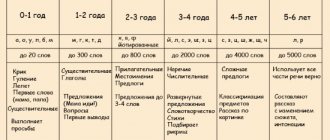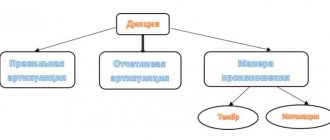“On Thursday the fourth at four and a quarter o’clock
the Ligurian traffic controller was regulating in Leguria,But 33 ships tacked, tacked, but never tacked..."
The above are typical exercises for improving speech and voice diction. They are great for both children and adults. From the article you will learn what articulation is and how to develop it. Examples of correct execution and tongue twisters will be given, as well as exercises for relaxing the tongue, jaw and articulatory gymnastics.
What is articulation
Articulation is the coordinated work of all speech organs (oral cavity, lips, tongue, teeth, larynx, cheeks, jaw) in order to produce sound. And good diction (that is, clear pronunciation of sounds) depends precisely on the development of articulation.
Diction and articulation are one of the singer’s main tools, along with support and proper breathing. The more clearly the artist sings the words, the better the listener understands him, the greater the effect the singing itself produces. If a singer sings with good support, but clenches his jaw and chews his words, then he is unlikely to sound beautiful.
Examples of good articulation
Watch videos of popular artists. Some singers are simply textbook examples of how the speech apparatus works. So, you have a lot to learn from Steve Tyler, Linda Perry and Alla Pugacheva.
In all examples, the active work of all speech organs, including lips and tongue, is visible. It is noticeable how wide the mouth opens.
In singing, vowel sounds are usually lengthened, and consonants are shortened as much as possible. However, consonants should still sound as clear as possible.
Let me remind you that the correct position of the mouth in pop vocals is called the “Vocal mask”. VM is the position of the mouth in which sounds are produced as beautifully as possible. The point of using a vocal mask is to learn to speak and sing with a smile. The mask makes the lips elastic and opens up a large space for sound delivery.
Development of diction in children and adolescents
Language development in children and adolescents requires the same attention from parents as study. His whole life depends on how others perceive your child. A teenager with a speech defect becomes an object of ridicule.
It is common for children and adolescents to “eat up” the endings of words, skip parts of words and individual sounds, and pronounce words in an unclear manner. Such deficiencies can be corrected at home. But obvious speech defects in a child can only be corrected by a specialist.
Why do they barely open their mouths in the videos?
Students often ask why we learn to sing with a mask, although in the videos many performers sing with their mouths barely open. The answer is simple: in the videos, the singers do not sing, but simply move their lips to the music. To see the real work of the articulatory apparatus, you should watch the song performed live.
Performed by the group "VIA Gra"
For example, let’s take the song of the group “VIA Gra” “Don’t leave me, my love.” In the video, the girls sing, barely opening their mouths, and sometimes even stop mid-sentence. Another thing is a concert where they sing live. It can be seen that all the performers sing with a smile, open their mouths wide and show their upper teeth.
A smile (or vocal mask) allows you to reach high notes and direct sound into the resonator, so mastering it is simply invaluable for a singer.
Performed by Sia
Should you always open your mouth wide when singing? No! For example, let's watch a video of Sia singing live. During the performance of the verse, the mouth almost does not open. Only on the chorus she uses a wide mask. Note, however, that this is an exceptional case.
The fact is that some singers, in particular Sia, use a style of closed singing: vowel sounds sound closed and directed into the hard palate - with a characteristic nasal tint. With this performance, you need to master the resonator and be able to correctly direct the sound. Let’s say right away: if you are fluent in resonators and know how to direct the sound where it is needed, you don’t need a mask that is too wide!
Read more about Sia’s performance in the article “Texts of the song Sia - Chandelier and full analysis” >>>
Performed by Billie Ellish
The Billie Ellish video is a completely different story: the sound is delivered with an absolute exhalation. The song sounds relaxed and sluggish, the mouth is motionless, as if numb. This performance, together with Billie's mermaid image, hypnotizes the listener. But don’t forget: in the right places she articulates everything clearly, all the words are legible. In addition, the video shows a masterful command of sound direction and resonators. The sound still goes where it needs to, and the combination of singing and frequent aspirations creates an absolutely complete and colorful picture. It is clear that the singer spent a lot of time on exercises for diction and voice.
Texts for the development of diction
When working on yourself, use a dictionary. Take words that are difficult to pronounce, repeat them several times, increasing the speed, for example: stay awake, philosophize.
In the same way, you can practice the combinations zh-sh, k-g, x, c, words with double consonants. “S-z” is easier to train if you select words with a vowel in front of them: fright, spark, get rid of. At the beginning of the word: sandwich, buzzer. In the middle of the word: atmosphere, shuddered.
Train other combinations in this way. To train l, repeatedly say proverbs using it, for example: “Love, love, but don’t lose your head.” Carry out training systematically, starting with articulatory warm-up.
A training option is reading prose text. At first, read aloud slowly, pronouncing each sound clearly.
Then - without sound, using articulation, lip movement. Then read the text in a whisper. After two weeks of systematic training, you will get a result that you will like. You will discover new things in your speech.
Choose complex texts, with difficult combinations and words: “Once the dandy Goldfinch found a box of rubble,” “On Thursday, the fourth, at four and a quarter o’clock,” “Sonka, Sashka’s girlfriend.”
Texts for training can be found in classical literature, for example, “The Dnieper is Wonderful in Clear Weather” by Nikolai Gogol.
How to develop articulation
To develop articulation, it is necessary to remove the “clamps” and strengthen the necessary muscles. The “clamps” are removed from the jaw to allow the mouth to open freely. Next, we strengthen the muscles of the lips, cheeks and tongue.
In this video I show how to improve your diction using a felt-tip pen >>>
To remove the clamps, you need to use exercises to lower the jaw and lay down the tongue. At the beginning of singing, the tongue may rise and puff up, tense and pinch the larynx. In fact, we only need the tongue to extract consonant sounds, but on vowels it lies freely behind the lower teeth.
Workshop: exercises for developing speech and voice diction
Exercise to relax your tongue
We take a chopstick (it can be a sushi stick, a pen, a spoon), open our mouth and stick out our tongue. We place the tongue with a stick, press it lightly and try to make vowel sounds in this position.
Jaw relaxation exercise
To lower the jaw, place two fingers vertically between the teeth. In this case, the upper lip should be raised. In this position, you need to try to extract the vowels “a” and “e”.
Achieve a certain rigidity in pronouncing sounds. The chants “ya-ya”, “na-na”, “di-da-do-doo”, etc. will help here. To train the lips - combinations of voiceless and voiced consonants “p-b”. For the larynx - “k-g”. You need to achieve a clear and at the same time “explosive” sound when working with consonants.
Tongue Twisters
Tongue twisters are good for working with consonant sounds, as well as on the mobility of the entire articulatory apparatus. They need to be spoken rhythmically, exaggerating the sounds and maintaining a vocal mask. You can make the task more difficult by placing two walnuts behind your cheeks or holding a felt-tip pen between your teeth. This creates extra practice and makes your speech very clear. After just one such lesson, you will notice the result and your friends in a telephone conversation will most likely also note the improvement in your diction. In any conversation, you will sound more convincing and people will listen to you.
Notice how clearly and expressively the specially trained managers speak when they are selling you something. This is due to the fact that clear speech has a strong impact on the listener, including vocals.
Articulation gymnastics
Articulation gymnastics is very useful - movements of the lips and tongue without sound.
You can do the following exercises:
- twisting in both directions and pulling the tongue up and down,
- pulling into a pipe and stretching the lips,
- rotation of closed lips in a circle,
- bringing the tongue into a “boat” shape, sticking it out, making it flat, narrow, raised, tense.
Articulation is closely related to pronunciation. In foreign languages, sounds are articulated differently; some sounds do not exist in the Russian language. This needs to be dealt with separately.
Articulation is related to rhythm: clear accentuation of consonants gives an additional “pump up” of the rhythm - this is why rap sounds so rhythmic. To perform it, you need to have excellent diction and a sense of rhythm.
It is important not to swallow or chew the endings of words: keep the sound until the end and remove it in a timely manner. This is a sign of high skill of the performer. The length of each word and sound must be predetermined, some words may be shorter and others longer. All this needs to be taken into account.
The importance of diction for humans and society
If we can speak clearly, this makes us successful and advantageous in communication. He is well understood: he clearly expresses his thoughts and pronounces words.
There is a range of professions that require the quality of spoken phrases. But the ability to speak beautifully is needed not only for the public. A person wants to be understood and accepted. Good pronunciation will give confidence, increase self-esteem, and become an indicator of success.
Often the ability to speak and voice are overshadowed by external shortcomings.
Nina Petrovna, who teaches psychology to students, after suffering from polio, one leg became much shorter than the other. Yesterday's schoolchildren laughed when they saw a lecturer with physical disabilities.
When the lesson began, the future teachers fell in love with the teacher.
The trained voice, measured tempo, melodic timbre captivated the listeners, helped to attract attention, achieve understanding and make an impression.
Poor diction leads to communication problems. Unintelligible phrases are poorly received by people with whom you have to communicate. There is no opportunity to concentrate or express your thoughts clearly. Self-esteem decreases and self-doubt develops.
It is especially difficult for teenagers with such problems to communicate. An incomprehensible reprimand prevents the child from learning and communicating with peers.
Diction exercises
“Adult” techniques help to change the pronunciation of schoolchildren and preschoolers, but carried out in a playful way.
To warm up, suggest biting the tip of your tongue, chewing your tongue with your side teeth, biting the inside of your cheek, sticking out your lower lip, giving your face an offended expression, making a tube with your lips, puffing out your cheeks and knocking out the air with your palms.
They teach the correct pronunciation of tongue twisters, phrases for practicing sounds, and pronunciation in front of a mirror. Collective games for the development of articulation are useful: “Watermelon Train”, “Walking”, “Echo”, “Zoo”, finger games.
The child must be able to correctly place stress in words and inflect different parts of speech. Then it will be easier to master the norms of the literary language.
Reading literary texts by role and aloud improves intonation and clarity of pronunciation. Children are interested in talking with nuts in their mouths, with a pencil in their teeth, and pronouncing words while walking.
If you regularly work on yourself, all these simple techniques will help you acquire correct speech skills and correct pronunciation defects.
Related posts:
- What is "War and Peace" about? Summary of the novel “War and Peace” by chapters. All answers...
- Exercises to develop diction How to improve your speech? Diction exercises will help you practice difficult...
- Logorhythmic classes and correctional means By various means, speech therapy classes contribute to the effective correction of speech in children...
- We speak soon, but we don’t pronounce everything. The development of diction is impossible without corrective exercises. Tongue twisters are suitable for both children...











